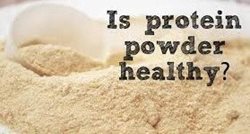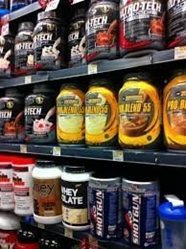 Recently, during my dreaded weekly pilgrimage to the supermarket, I found myself walking down the aisle that houses the magazine racks. I’m not sure why, but my eye seemed to be drawn to the section of the rack that is filled with “health” publications, and I use the term loosely. There was no shortage of headlines adorning their covers like “Instant Muscle,” “Get Jacked,” “Huge and Ripped,” “Maximum Mass,” blah, blah, blah. Of course, they all had an obligatory accompanying cover photo of someone pumped up, oiled up, and spray tanned in an effort to motivate and entice me to pick up, thumb through, and buy into whatever they are promoting. Have you ever actually looked through one of these supplement catalogs, er…ahh… I mean magazines? Seems to me like the ads outnumber the articles 7 to 1 and the articles themselves are often times promoting whatever supplement is filling the ad space like an Old West snake oil salesmen.
Recently, during my dreaded weekly pilgrimage to the supermarket, I found myself walking down the aisle that houses the magazine racks. I’m not sure why, but my eye seemed to be drawn to the section of the rack that is filled with “health” publications, and I use the term loosely. There was no shortage of headlines adorning their covers like “Instant Muscle,” “Get Jacked,” “Huge and Ripped,” “Maximum Mass,” blah, blah, blah. Of course, they all had an obligatory accompanying cover photo of someone pumped up, oiled up, and spray tanned in an effort to motivate and entice me to pick up, thumb through, and buy into whatever they are promoting. Have you ever actually looked through one of these supplement catalogs, er…ahh… I mean magazines? Seems to me like the ads outnumber the articles 7 to 1 and the articles themselves are often times promoting whatever supplement is filling the ad space like an Old West snake oil salesmen.“Bro-Science”
I think it’s no secret that they ALL want your money, and they will claim and say anything to convince you to give it to them. One of the most popular products being offered up in those publications is protein in all its different forms, mutations, and splendor. I may be speaking in generalities here, but it seems to me they sure are pandering to the ‘Bro-Science’ crowd. You know that crowd of guys who put more trust in the anecdotal investigative reporting skills of jacked, knuckle-dragging Neanderthals instead of researching and accepting the information from a credible independent scientific study.
 How Much Protein Do I Need?
How Much Protein Do I Need?This is where “bro-science,” which has totally bought into what those muscle rags are selling, comes into play. I get asked all the time, ”how much do I need to take?” Take a second and think about this. The major ad sponsors for all those rags are trying to sell as much of their product as they can. So, it goes without saying their number one goal is to convince you that you HAVE to have their product in order to get the results you want to get. So, they are basically trying to shove as much of their stuff down your gullet as possible. The more you use, the more money they line their coffers with. You picking up what I am putting down?
Now, “how much protein do I need?” is a little bit of a tricky question to answer. If you really want to get dialed in on it, there are some variables that factor into exactly how much protein you need, i.e., height, weight, age, gender, and activity level. With that being said, if you Google it you will get some interesting results. For instance, when I use my own personal variables and compare them to both the FDA’s set of recommended daily allowance (RDA) and Harvard Medical School’s, I should be getting 70g of protein a day, while WebMD recommends I should be taking in 56g of protein a day. Now if I were one to take my advice from one of those highly supplement endorsed publications like Bodybuilding.com, I should be consuming 134g a day to maintain my current petite, desert flower figure. Not convinced? GNC.com suggests I take 128g of protein on board a day. See a pattern here? Can you guess who is trying to sell product?
How Much Protein Do I Normally Consume?
The typical North American diet does a fine job of meeting the RDA for protein. Again, I will use myself as an example. Two fairly common morning breakfast items that rotate through my morning routine is either hard-boiled eggs or Greek yogurt. So, depending on if I eat two eggs or the yogurt I will have between 12g and 17g of protein. Say I have a chicken breast in my lunch. That’s around 30g of protein, give or take a gram or two. So, if I do the math on that, it puts me between 42-47g of my RDA requirement in just two meals and we haven’t even figured in a couple of snacks and dinner yet. It’s really not that hard to hit your RDA minimum.
If I Am Going to Supplement, What Is the Best Form of Protein?
If you just can’t help yourself and you feel like you must supplement protein, let’s at least educate you on what’s what. It can be confusing with so many variations of protein: isolate vs concentrate, complete vs incomplete, whey vs casein vs soy vs hemp vs rice, etc., etc…. Where to begin?!?!?
Let’s take a step back and define a couple of key terms you will often see associated with different protein brands.
Key Terms
- Concentrate- This is pretty much what you think it is. It is protein that no matter what edible source it came from has been “concentrated,” attempting to remove everything but the protein. This usually results in a product that is 70-85% pure protein. The remaining is mostly carbohydrates and fats.
- Isolate- An isolate is simply an even higher protein concentrate. Isolate product claims are upwards of 95% pure protein.
- Complete- There are nine essential amino acids. Essential meaning the human body can’t produce them. A product that claims to be “complete” means that it contains all nine essential amino acids. With that said, I am guessing you can figure out what an incomplete protein means.
Varieties of Protein
 Ok, now that we have defined a few terms for you, let’s look at some different types of protein. A little disclaimer: this is not an exhaustive list of types of protein, just a list of the more common types of protein you might see.
Ok, now that we have defined a few terms for you, let’s look at some different types of protein. A little disclaimer: this is not an exhaustive list of types of protein, just a list of the more common types of protein you might see. - Whey - This is by far the most popular of them all. Think “curds and whey” here like the old nursery rhyme, meaning it is a by-product of turning milk into cheese. With that in mind, if you have any issues with dairy intolerance, this is more than likely not going to be your first choice. The good news is that whey protein is fairly inexpensive compared to other types of complete protein and is quickly absorbed, making it very popular as a post workout beverage of choice.
- Casein - Very similar to whey in that it is milk based protein. The main difference between casein and whey is that casein is much slower for the body to digest and absorb, so it isn’t the best choice for post workout applications.
- Egg - Simply put, this complete protein is produced by separating out the yolk and dehydrating the egg white. One of the benefits here is that you will tend to find egg protein powders are naturally rich in vitamins and minerals as well.
- Soy - This one has drawn some controversy as of late. On the pro side of the discussion is that it is one of the rare sources of complete plant proteins that we have and may help with immune function, bone health, cardiovascular disease, and reduce the risk of some cancers. On the con side is that it has come under fire because it is one of the crops that is often genetically modified. There has also been some recent research looking into the effects of soy on hormone levels that brings into question the use of soy as a cheap protein source in food.
- Rice - Whoa!!! Hold the phone?!?!? Rice, as in rice protein?!?!? Yes, I didn’t stutter. There is protein in rice. Ya, ya, I know it is more commonly thought of as far as carbs go. The big plus for brown rice protein is that it is hypoallergenic which in other terms means it’s easy to digest and almost completely used by the human body. The downside is that it is missing several amino acids so it isn’t going to be recommended as your main source of protein.
- Hemp - OK, stop snickering. We are talking about the protein derived from the seeds of the cannabis plant here. Nice try if you were thinking about trying to meet your daily RDA intake of protein while getting baked. It is often referred to as a super food, is vegan-friendly, and is another widely hypoallergenic source. However, since it is mass harvested in only a few countries, it is usually the most expensive form of protein you can get.
- Pea - This is a source that seems to be slowly gaining traction due to its appeal to the vegan/vegetarian crowd. Just like most plant-based proteins, pea protein is also hypoallergenic. The downside, like most plant-based proteins, it lacks certain amino acids so it shouldn’t be your main source of daily protein.
- Quinoa - This is something that certainly seems to be riding a strong power curve and is becoming more popular by the day. It is one of the few plant sources that are considered a complete protein source as well as a source of fiber and many vital micronutrients. Take care to read the label before you purchase protein powder made from quinoa. There are several brands out there that combine quinoa protein powder with whey protein powder in their product. So again if you are one who has dairy issues this is something to look out for!
Conclusion
As you can guess, I personally am not a regular protein powder user, and it seems to me if I was I would just be flushing money down the toilet. I will admit to you that I do have a bag of Costco size whey protein that I have owned for going on three years now. The only time I use it is as a meal replacement in a pinch when I am in a huge hurry. Like I said, that bag is about three years old now so you can guess how often I actually dip into it.
As always I would encourage you to research credible sources before investing in something just because someone in a gym swears by it. Don’t take any article you read at face value either. Find out who wrote it. Then look them up and find out who they work for!
Tim Clark, Manager Fitness Club
Community Medical Center Fitness Center


